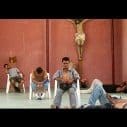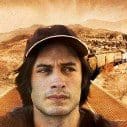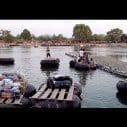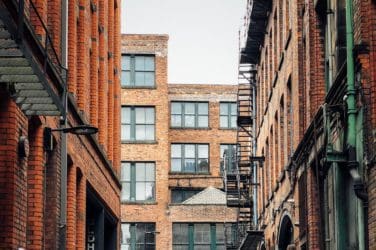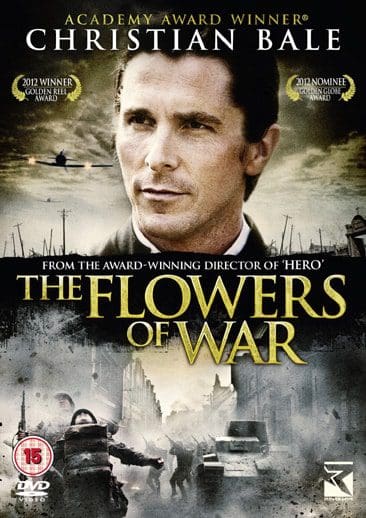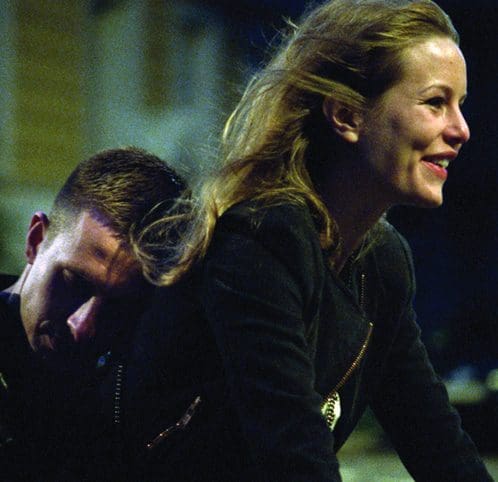Documentary filmmaker Marc Silver tells how he searched for the answer to the question of, “What one skull can reveal about the world?”
It sounds morbid, but in truth Silver turns his camera to observe a divided world in which lies the tragic story of migrants who aspires for a better life and risk hardships to fulfil their human desires.
Tragic is the only adjective to describe the story of Dayani Cristal who is only one of the many migrants to be claimed by the treacherous journey that they hope ends with a rendezvous with the American Dream. But Silver explores the optimistic dimension of the story of migration on the Mexico-U.S. border, and how some of the fallen migrants, the fortunate few make it back to their families whilst for the rest they become a file in a database, their identity; their soul claimed by the hopeful journey that ends in tragedy. Silver brings the journey to life as Gael García Bernal retraces Dayani Cristal’s route, offering simply not an investigative conversation of his fateful journey, but an authentic insight that allows us to understand it as well as we may ever be able to.
Speaking with Silver he is quick to stress that whilst this film centres on the Mexico-U.S. border, it looks beyond this one geographical location to the international community’s confrontation with migration. Talking to us early one morning before disappearing into the edit suite, Silver reflected on the film’s genesis, and looked ahead to how the film might play to a future audience. He also spoke to us about humanising the image of the migrant, and merging cinematic dialects to tell Dayani’s story.
What was the genesis of Who is Dayani Cristal, and how did Gael García Bernal become involved in the project?
“Seven or eight years ago I decided that I wanted to re-explore the long form documentary, and it was in the days before Occupy that we launched the web site that asked for people to send in stories of resistance against walls and barriers; of divisions between rich and poor. One of the stories that came in was the story of skulls being found in the Arizona desert, and as we looked at one of the photos of the police holding a skull in this landscape, we asked ourselves, “What one skull can reveal about the world?”
Gael was involved from the beginning when we launched the web site, but at that point we didn’t know what the film would be. We only knew that we wanted it to start at the wall between Mexico and the U.S. which is one of the most recognisable images of the disparity between rich and poor countries.
While we were researching the film we actually made four short films for Amnesty called The Invisibles, which were about the human rights abuses that migrants face travelling through the Mexico part of the journey. This was going on in parallel to researching the story in Arizona, where we were getting access to the morgue, the Mexican Consulate, and the rescue police. The four short films we made for Amnesty acted as research trips or inspiration for Gael to start to understand some of the stories of why people leave home, and confront the dangers of that journey, even before they reach the desert area.”
In discussion of the writing process of Top of the Lake, Jane Campion spoke of how a story is comprised of not one but several ideas. From what you have said about the genesis of Who is Dayani Cristal it seems that you have experienced something similar through separate projects informing one another.
“I think that’s actually true, and I’ve never been one to define either myself or a project as one thing. I am interested in trying to find the small human story that speaks to the large systemic problems or universal issues. I sometimes perceive film or rather the films that I want to make as Trojan horses, and in the case of Dayani Cristal it might appear to be a film about the Mexican—U.S border, but it is actually about something much larger. This is done when I am initially kicking around ideas; trying to find ideas that are good enough and which are small on the surface but can conceptually carry a lot of things within.”
To pursue a dream, a better life is admirable, and in watching the film I became more aware of the human identity, the life story, and the aspirations of these immigrants as the adjective of migrant is broken down and humanised.
“It wasn’t as if we were trying to persuade people to form political opinions that were more positive towards migrants. The intention of the film is literally what you just said, and for me some of those issues are beyond political divisions. I think part of trying to humanise some of these big subjects whether be immigration, or guns and racism in the U.S. in the film I am currently working on, is that the politicians use them in such a way that the polarisations are taken advantage of. It is good once in a while to remember there are small human beings at the centre of some of these policy decisions, who undergo horrific hardships.
I remember how I would come back to England while I was still shooting the film. I’d just be in the pub with friends and there were these moments where I would look around and think this is so beyond politics. If me and my friends were living in that village, and whether we aspired to earn a living for our families or if our hopes, dreams and desires went beyond what we could achieve there, then I’m sure beyond the politics of the situation we would want to make that journey north. Once we start breaking down that perception of the “Other” and start to see these things as universal desires, then maybe that will shift like a pixel, and maybe that change will start affecting in a very small way the politics behind the big issues.”
Film is often described as a journey, and half of Who is Dayani Cristal? is a reconstruction of the migrant journey whilst the other half is the investigation. How did you arrive at this construct?
“Well in a funny way we were told from the beginning by the people in the morgue that we were never going to be able to pull this off – from being there when the police discover a body all the way through to identification; to the actual finding of the family, and then getting their permission. So at the beginning the production company and I essentially co-funded the first year of the project, because to put it in crude film terms no one was going to give us the money until we had the story of the body all the way home. So it really was me on my own filming all of the Arizona and Honduras footage.
Once in the edit we knew we could jigsaw puzzle the pieces of the police discovering the body, the investigation in the morgue, and then whether it went to the Mexican or Honduran embassy depending on the nationality of the body, before going all the way back to the family. This took roughly a year from the first time I went to Tucson to when I arrived in Honduras with Dayani Cristal’s body. But once we could show funders that we had that part of the story, we could then get access to the funding for Gael’s road trip.
It was a very risky endeavour in terms of never knowing if any of those bodies or skeletons would lead to a discovery of the deceased’s family. So we knew from the beginning that was the structure we wanted, but in a documentary way it was a case of keep your fingers crossed, and keep on going until the story doesn’t work anymore.
We were very fortunate, and all joking aside, from the filmmaking side of it in the morgue we were statistically up against it. Of those two thousand bodies that have been sent to that morgue, there are seven hundred that are yet to be identified. So we were very fortunate that this particular body was identified so quickly compared to the others.”
At one point in the film we are told how just that one office alone has a thousand cases in its database. Whilst the words carry a weight you use a single image of the files on the shelves to punctuate the dialogue. I perceive image, sound and dialogue to be three dialects within this one art form, and when brought together they inform and touch our sensibilities.
“We were very aware of the fact that in the U.S the subject of immigration is everywhere. It was a highly divisive subject, and we didn’t want a lot of unnecessary voices in the film. The power of the imagery is obviously extreme in some cases, and to use the old cliché, “An image can speak a thousand words” was in this case true. When you look at some of those images in the morgue or in the village, there was a power that could never be spoken in words. When it came to the politics of the story we also had an unwritten rule that we only wanted to speak with people who had in one way or another been in touch with the body, whether it be the family or the investigators. We were very lucky that the brother could speak of these bigger political issues.
One of my favourite lines in the film is about why we invest all of this money in the wall, which is just an inanimate object, rather than investing in the development of humans. There are some fantastic and overtly political comments from the people in the morgue, but because they are dealing everyday with the skeletal remains of migrants, I think they are justified to have that opinion; more so than if you are just a talking head pundit in Washington.
We tried to craft out of the minimum amount of words from those people, and combine them with some powerful images as well as sound. But there is a Venn diagram of those three things crossing over to try and create this mood throughout the film.”
From before to after, how did the experience affect your perspective both personally and professionally?
“At this point in my life it solidified a belief in the power of empathy. It also made me think about a time in which data and information is everywhere, yet how sometimes that data and information doesn’t really have an impact. From the audience’s reaction at screenings I came to understand that the power of empathy was having more of an impact, and it gives people a deeper understanding than facts and figures can. That is not to say that facts and figures aren’t important because they are. But in the type of filmmaking I undertook with this film I was interested in looking at how big systemic issues affect small individuals. By revealing the impact on the individual, you are revealing these bigger problems, though not by finger waving or shouting. Instead you are doing so in a way that is much more subtle and gets under the skin. I think that is what I have learned art wise, career wise or filmmaking wise.
What this skull revealed to me about the world is that there are hugely complex transnational economic structures that combined with the drug trade from Central America means that it will be a long time before any of the problems of our film are solved in any big systemic way. Of course there are small things you can do either as an audience or as an individual to alleviate some of the problems we feature in the film, but for the actual systemic problem to change is more complex. But what one body in the desert can tell you is revealing.”
As the issue of immigration continues to evolve, how do you think your film will play to and resonate with an audience in twenty, thirty or even forty years’ time?
“It’s funny you ask because I have been thinking about this recently. You do the whole film festival circuit, encounter all the chaos and frustration that surround the releasing of the film, and sometimes I try to consider how most people’s reaction to the film is short term, which in turn makes me think about your question. I do wonder how this will sit in twenty or thirty years’ time. On reflection it might be a warning sign because I can’t see a way by which these problems will decrease over that time.
A lot of what we are doing on social media is simply posting stories about how this is not just a film about the Mexico-U.S border. There are a mass of migrants in the Mediterranean travelling from North Africa to Southern Italy, and it is the same between Indonesia and Australia. Recently the story has broken about how there are fifty thousand children from Central America, a lot of who are from Honduras that are now sitting in detention centres on the border of the U.S. I don’t think that we’ve been prophetic, but the story of death in the desert is a signal as to how the next twenty, thirty or even forty years will go.
I did an interview with an academic solely for my own research four or five years ago now, and she told me this shocking fact. The numbers might have evolved since then, but since the fall of the Berlin Wall something like thirty five new walls have been built between nation states. So whilst we have this image of the world being more open; more globalised; friendlier and easier to get around; the reality is that essentially for poor people there are thirty five new barriers to cross. I can only imagine that this will become more intensified as disparity between rich and poor nations becomes stronger, and the militarisation and fortification of borders grows stronger.”
Interview with Marc Silver by Paul Risker.
A preview of Who is Dayani Cristal? will be screened as part of DocHouse’s July programme on Thursday 24 July, at The Rich Mix Cinema with an exclusive Q&A with director Marc Silver.
See the Dochouse Website for details.
Who is Dayani Cristal? is in UK cinemas from 25 July, and at the Manchester Cornerhouse from 1 Aug. See the film facebook page for details.


